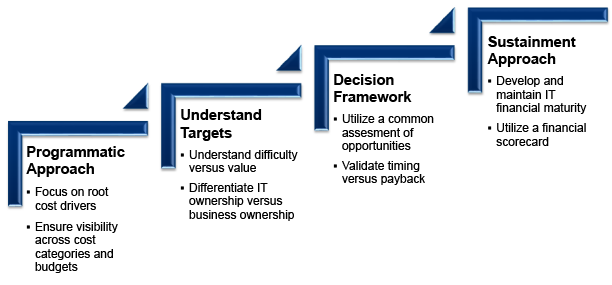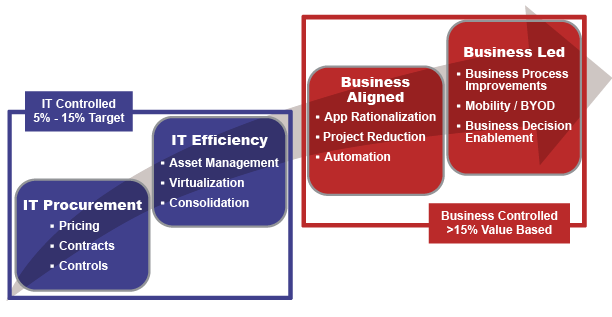
Computing
IT Optimization Drives Long-Term Benefits
By Lawrence Eribarne
HOUSTON–Unfortunately, cyclic commodity markets and the resulting business demands are major factors that force organizations in the upstream oil and gas business to continually adapt to change. In the realm of information technology, however, cost pressures during commodity price downturns can become an opportunity to improve IT value and business partnerships, and enhance the ability to drive greater success in the future when the market cycles back upward.
The truth is, adopting a short-term focus on reducing IT-related capital spending can have long-term ramifications. Big-picture views of IT strategy, architecture, delivery, and business alignment/competitiveness should not be lost in the effort to improve bottom-line costs in response to temporary market conditions. Creating significant and sustainable cost optimization requires a comprehensive approach that crosses all IT budget owners and maintains or improves business delivery.
Knowing where to focus when times are tough is just as important, if not more so, than focusing on the right activities when times are good. Therefore, optimizing IT should be a strategic endeavor that leverages collaborative processes and analytical models to improve long-term IT value while supporting business alignment and enhancing business performance (Figure 1).
IT optimization provides a sustainable efficiency model across IT delivery and services, allowing for various levels of impact to individual departments. Consequently, there is a heavy dependency on opportunities that extend across budgets, requiring collaboration and transparency, as well as an IT management view that encompasses an enterprisewide value focus. The goal is cumulative efficiency, rather than focusing on any single area alone. Once targets are identified, an analysis is conducted using a common approach and set of tools to ensure all opportunities are evaluated and selected fairly.
Key Optimization Tenets
To be effective, measurable and sustainable, the key tenets of an IT optimization program should include:
- Short-term, mid-term, and long-term actions and objectives;
- A focus on enhancing business delivery and delivery models; and
- Optimization key performance indicators (KPIs).
IT optimization should be permanently incorporated into ongoing IT performance management. Cost metrics have a rightful place in every IT executive scorecard and dashboard, regardless of business conditions. When oil prices are down, additional clarification of the levers and delivery impacts should occur. This allows an immediate and balanced response to the prevailing business environment, thereby mitigating the potential long-term negative impact to the value chain.
The effectiveness of IT optimization cannot be measured within the silo of an IT budget alone. While it is much easier for IT groups to target “quick wins,” truly impactful IT-related economic benefits extend and compound over time. Shifting the budget over a few periods can be insignificant compared to the overall cost optimization IT could drive within an organization over time. Therefore, IT optimization KPIs should focus on long-range enterprise value goals.
Focusing on short-term IT cost cutting rarely results in measurable, sustainable, efficiency gains. In fact, it can deliver negative effects that erode delivery capabilities, bringing IT out of alignment with business expectations, or causing a budget overrun in a different area within the company. Without analysis and program oversight, seemingly straightforward cost improvement efforts can quickly drive unanticipated consequences, and rectifying those situations may ultimately prove very costly
Critical Success Factors
Identifying, analyzing, and capitalizing on IT optimization opportunities is dependent on several critical success factors (Figure 1). In order to achieve a successful impact on IT value, the cost optimization effort requires a holistic and programmatic approach. The focus must shift away from individual cost drivers toward a model of transparency. The most impactful initiatives will cross multiple IT budgets and may impact various areas differently. In fact, many of the largest reductions could require an investment in another part of IT or within the business.
A programmatic approach is required to understand cost and opportunities, not only within budgets, but across functional IT areas. An additional element of analysis must consider the accountability and ownership of the opportunity. While many cost opportunities are completely within the influence of IT, others may require business agreement or full business leadership.
Each optimization target will require detailed analysis in order to understand the impact, risk, commitment, value timing, and level of business commitment required to optimize successfully. Tradeoffs exist between these factors for each target. Understanding the impact of these tradeoffs, and the level of business sponsorship required, will drive the target selection, timing, and achievable levels of optimization allowing for transparent, comprehensive decision making.
Initial target identification often falls within IT ownership and focuses on IT-controlled areas, with minimal requirement for business consensus. However, focusing only within IT-owned targets limits the total program opportunity. Internal IT targets can often yield up to 15 percent reductions in overall IT expenditure within some environments. Opportunities that require business sponsorship, such as restructuring, process automation or business decision enablement, can far exceed 15 percent (Figure 2).
Evaluating the tradeoffs requires a standardized approach. The framework does not necessarily require undue complexity, but companies must leverage the framework in a consistent manner. Tradeoff analysis considers overall benefits to the organization, required levels of investment, the timing of value achievement, the degree of business impact, the level of change impact on the organization, and assessing the technical risk. Companies may also include decision elements that are specific and meaningful within their organizations.
Another key consideration in the decision framework is knowledge of the last time a particular opportunity was pursued. When business conditions drive cost-efficiency requirements, many IT groups attempt to return to tried and true targets that achieved reductions in the past. While targets such as such as network bandwidth or data center space may have previously yielded significant opportunities, once these types of opportunities are achieved, they rarely yield similar impact levels. All target analysis frameworks should include a date for the last time the target was pursued, and the resulting outcome. While a company may wish to pursue a given target again, it will likely fall lower in priority when compared to new targets.
After gathering appropriate data and considering the tradeoffs within each opportunity, the targets can be prioritized and reviewed for dependencies. Some optimization targets may appear less impactful, but are required to enable key capabilities that unlock more significant optimization activities later in the program.
Sustainment Approach
During the focus on optimization, significant effort is applied to understanding cost drivers, relationships, and impacts. Once targets are selected, prioritized and achieved, sustaining the same level of focus, transparency and financial analysis may require a long-term commitment to IT finance maturity. Many IT organizations lack financial skills, tools or metrics to maintain visibility and focus on continued optimization.
Understanding the gaps in IT finance maturity is critical to transforming into a value-based organization, partially achievable through a IT cost optimization program. The maturity path within an organization should progress toward value-based metrics and decisions, culminating in using a value-based approach in operations, project investments and governance activities. IT financial analysis is the key to decision processes with the business.
Sustaining a focus on optimization and value requires proficiency in three key areas:
- Financial management;
- Investment governance; and
- IT asset management.
Financial management requires having the appropriate tools and reporting technology to maintain transparency across the enterprise, including historic trends, cost relationships and forecasts. It also requires tracking all improvements and impediments to IT operations and efficiency, including the impact of business demand, compliance, security and efficiencies within project business cases. Moreover, companies should maintain a view of cost relationships. This could include computing costs driven by increased utilization, network bandwidth due to company growth, licensing growth due to mobility initiatives, and other key strategies.
With respect to investment governance, companies should validate, assess, measure and prioritize all demand on their IT organizations and the impact on maintenance costs. Financial measurements can be consistently applied to fully understand the value proposition of IT investments, ensuring that project investments are balanced across value achievement and strategy progression. Some projects, while not entirely justified through value progression, may still lay the foundation for strategic progression and business impact.
IT asset management processes should ensure all IT assets are fully tracked and associated to related costs, and that asset utilization is tracked to ensure maximum return on investment.
An additional enabler for sustainability is a well maintained financial performance dashboard. IT operating and capital expenditures should be analyzed regularly for alignment KPIs tied to measures such as enterprise IT cost goals, IT spending as a percentage of oil production costs, IT investment targets, etc. There are numerous metrics that can provide more meaning within specific enterprises. The key consideration is to establish KPIs and track IT performance against those metrics to maintain transparency, drive accountability, and mature the understanding of IT decisions on both immediate and long-term value enablement.
IT optimization requires consolidated accountability and transparency within IT organizations. Gaining the leadership skills, financial tools and optimization methodology can make IT a true partner with the business, doing its part to keep the company successful while holding ground on capabilities that will drive even more success once the market turns around.

Lawrence Eribarne is a director at Enaxis Consulting, with over 20 years of experience as a technology leader performing information technology organizational transformations as both an industry leader and IT advisor. He has a cross-industry background covering media, technology, military, and a strong emphasis on energy and manufacturing. Eribarne focuses heavily on IT strategy, portfolio management, cost optimization, operational process improvement, and value realization. He holds a B.S. from the University of Houston and an M.B.A. from Texas A&M University.
For other great articles about exploration, drilling, completions and production, subscribe to The American Oil & Gas Reporter and bookmark www.aogr.com.








